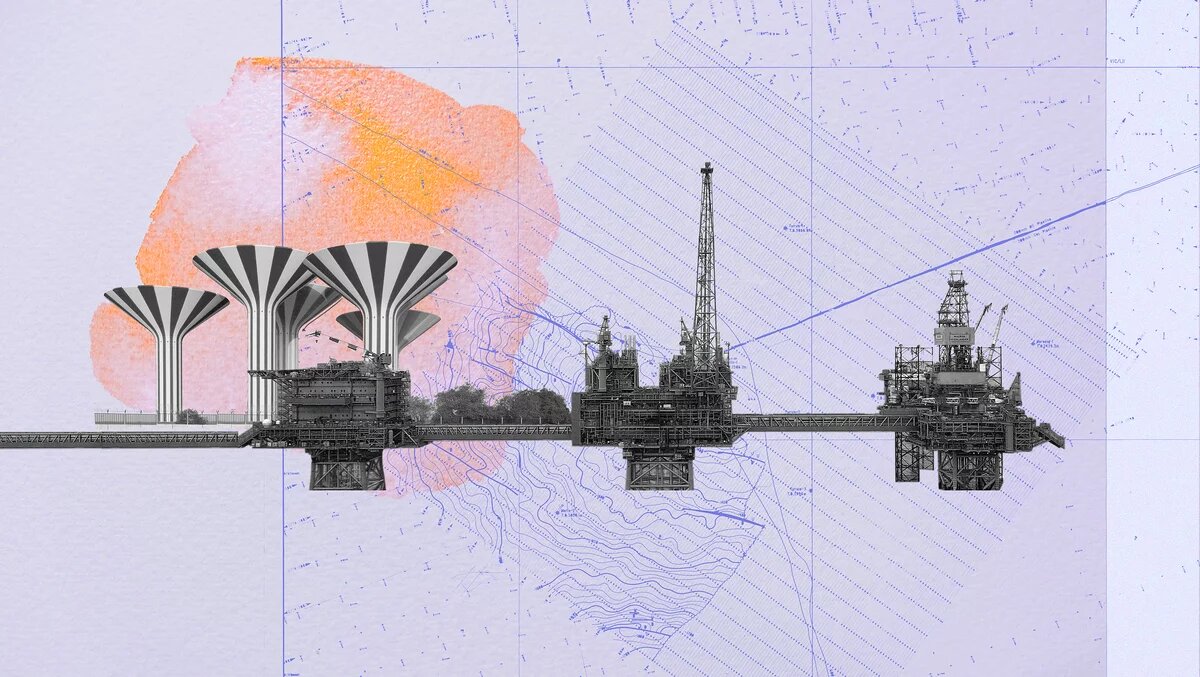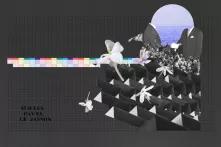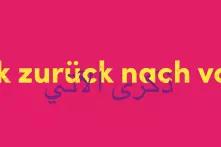In a brilliant and personal essay on the history of Bidoon literature, Mona Kareem shows why literature cannot be thought along national lines.

1.
Here we are in exile once again. We’re not the first Arab generation to cast itself into the labyrinth, and we won’t be the last. Sometimes they call us migrants or refugees; at other times they call us marginalized—then they invite us to talk, from the margin, about the margin: “How’s the weather over there on the margin?” They put us in anthologies that no one will read but the mummies in Middle East Studies, and they consider our poems and novels as documentaries, or treat them as confessions from the dark end of the tunnel. Perhaps there might be a little progress, consisting of a hyphen, tantamount to a mist-shrouded bridge, being placed between our identity and theirs: “Arab-American.” It’s a bridge not intended for crossing, one they take it upon themselves to guard; someday they’ll erect an electric fence on it.
I’ve spent ten years in the USA now. I haven’t obtained nationality yet, so I still travel on a twelve-month refugee passport, each annual renewal taking three months on the grounds that travel is a luxury. I am referred to, without hesitation, as an “Arab-American” writer; I don’t know when exactly this transformation occurred, shifting my classification from “exiled Arab” to “Arab-American.” By contrast, I was born in Kuwait and raised there until the age of twenty-two, by which time I had already published two poetry collections and worked for five years for local newspapers. In fact there was hardly a field I hadn’t dabbled in, from acting to theater criticism to literary translation to political organizing—feminism, workers’ rights, and the Bidoon cause.[1] I also played violin, oud, and piano, and if my voice hadn’t been thin and ugly, you would even have found me singing in the shopping malls and on the polluted beaches of the Gulf. I lived large during a short life, succeeded and failed and grew, all of it without a denotation or a classification to my name.
In 2011, after the Bidoon movement was born in the streets, there came to be something known as “Bidoon literature.” Prior to that, “Kuwaiti literature” anthologies and encyclopedias had ignored our very existence, their raison d’être being to shore up the idea that Kuwaitis actually had such a thing as a literature—and that by extension they also had a nation, a history, and a state. They excluded us Bidoon from the Kuwaiti Writers’ Association and from all public benefit associations. Although these are supposed to be more democratic than the state, they are in reality even more reactionary, grim, and racist than the state is. We would chat with our migrant comrades—the Egyptians, Syrians, Palestinians, and other Arabs wandering lost in petroland—and make friends with them in the knowledge that all of us existed on the margin, the margin of here and the margin of there, without knowing how to create anything out of this margin—a geography of our very own, say, or at least a space based on something other than His Lordship Mr. Citizen. “Bidoon literature” would never have been born without the birth of the Bidoon movement. Every political cause has an innate need for literature, for culture, to voice the suffering of a people and recount their progress towards their collective aspirations. Someone’s profile would be defined by the single vague line “born in Kuwait,” with the phrase “a Bidoon poet” deleted by the editor, because how can anyone be defined by a negation?
2.
If we go back to the history of literature prior to the nation-state, which first arose in Europe, we can observe how literatures were originally classified according to language, not geography. Some authors also wrote in more than one language, or were at least fluent in another language in addition to their mother tongue. This was equally likely to be the case whether they were in the East or the West. Today, that world sounds like a fairytale. There were some early attempts in modern literature—especially by the surrealist movement—to make internationalism the goal of the literary community, but they all met with failure. Even Arabic literature, the far-flung reaches of whose vast locality were always accessible to each other—and to the minorities whose people write in this language—has now been dismembered along state or regional lines. Indeed, modern literature is moving in the opposite direction to internationalism, towards the minority and the community, with community being defined by a single point: the issue that brings it together.
Bidoon literature did not come into existence simultaneously with the Bidoon movement, after the revolutions. Rather, the first published text by a Bidoon writer was by Sulaiman al-Fulaih, in the 1970s—a decade after the independence of the state and the birth of the community. Al-Fulaih was later forced to migrate to Saudi Arabia, where he worked for years in local newspapers and continued publishing his work. However, he remained a stranger to the literary scene there, staying close to his original one instead; so it seems that one’s Bidoonism does not end with merely obtaining nationality, or changing one’s place of residence. During the 1990s the Bidoon dominated the poetry scene in Kuwait. By virtue of being banned from studying or teaching in universities as well as from public-sector employment, most Bidoon worked in the Kuwaiti press. They co-edited the cultural pages with Arab migrants, organizing literary events and seminars and then writing about them, or writing pieces sparked by them, in the press.
The Bidoon literati did not think of themselves as constituting a distinct group within a literary community of foreigners in a country whose cultural sector had collapsed in the wake of the Gulf War. They simply considered themselves individuals on the margin, so there were no attempts to present Bidoon writing as necessary or urgent. Most of them found a comfortable space for themselves in poetry—where it was comparatively less dangerous to write about identity and belonging and pillaging. Some critics traced the Bidoon preference for poetry over prose narration back to their Bedouin culture, which would be a reasonable enough interpretation if it wasn’t for its narrow horizons. The funny thing is that poetry was not actually ever safe as far as the Bidoon were concerned: all of us have always heard about visits by state security to poets’ homes, or decisions to fire Bidoon from the Kuwaiti press. Fahd Aafat is perhaps the most famous example of this, given that he disappeared into the prison system for a while on account of a poem that was interpreted as satirizing the Kuwaiti Emir, before later reappearing as a migrant in Saudi Arabia and the UAE.
Usage of the term “Bidoon literature” has increased in the last decade, with a growing interest in the cause on the part of new academics, whether from Kuwait or in the West. The new Arabic and global exodus towards the novel has also had an influence on Bidoon books. Naser al-Zafiri, who migrated to Canada in the 1990s and died there two years ago, is the author of the novel cycle Al-Jahra's Trilogy. The trilogy attempts to recount the history of a community transitioning from life in the desert to the ashish, the popular housing projects in which the community was concentrated, progressing through the story of their lives in the petrol cities. It fluctuates between the shock of modernity and the aspirations of a Bidoon generation raised in a growing pluralistic society that was not as excluding as it seems to be nowadays.
We find that pivotal period in the life of the Bidoon appearing repeatedly in Bidoon writings, whether in al-Zafiri’s oeuvre or that of others from his generation, such as Karim al-Haza’a, and in the work of poets such as Dakhil al-Khalifa, Sulaiman al-Fulaih, and Ahmed al-Dusari, as well as a young novelist such as Khalid Turki. But many of these literary narratives tend to flow in one sole direction, with a focus on belonging—in its problematic and sentimental sense. This preoccupation is played out most starkly via the character of the Bidoon soldier, veteran of the 1967 and 1973 wars and then the Second Gulf War, considering him as a representative of the highest form of state allegiance and patriotism. In contrast, we find that the discourse of the state and the hegemonic class often exploits the same point to portray the Bidoon as hired mercenaries.
3.
In exile, I have met other Gulf peoples. Their origins on paper are India, or Iran, or Egypt, or the Philippines, and some of them write in English, but they were born and raised in the Gulf and then ended up in exile for one reason or another. They define themselves as “a writer from Abu Dhabi” or “a poet from Dubai” even though some of them don’t speak Arabic. Through reading their textural conjuring of a whole other Gulf I came to understand that my imagination had fallen victim to definitions of national literature. How have state institutions in the entire Arab world pulled off corroborating the notion of national literature as literature written by citizens, and necessarily in Arabic? Literature linked to state identity and state narratives, rather than to geography, which is in reality the natural vessel for any creative act. The state formation system across the Arab world—or even across the Third World as a whole—has been downloaded like a revelation received on the same template everywhere: in order to create your state, you must manufacture a folkloric culture, a literature, some arts and a traditional local dress, and then the lie is bound to become truth. Gamal Abdel Nasser dispatched his specialist committees to every corner of the Gulf, to organize cultural operations and trajectories that have come to be repeated ever since by successive generations of citizens who guard over them, their chests swelling with pride. And within these violent operations, no one leaves any space for the migrant or the Bidoon—or any other passerby stranded along with them—to join in and contribute with their own cultural production.
I grew up in a country where, after the Second Gulf War, the state TV channel used to cut the names of Palestinian or Iraqi artists from the credits of drama series and other programs, even going as far as erasing entire scenes from “their” national culture because they were acted in or made by the new enemy. People passed cassettes by Kadim al-Sahir and Yas Khidr to one another under the table, in the same way forbidden substances like wine and hashish were circulated. After the occupation of Iraq in 2003, people celebrated national holidays in Kuwait in a different way, crowding the Gulf beaches in their cars to sing Iraqi songs at the top of their voices. God, so freedom is to listen to an Iraqi song in public!
In his engagement with Abdel Rahman Munif’s Cities of Salt cycle of novels, the Indian novelist Amitav Ghosh wrote an exceptional essay titled “Petrofiction,” which blasts the entire Gulf literary project. Ghosh discusses how no literature anywhere has known how to deal with the discovery of oil; the extraction of crude, which has changed the balance of power across the whole world, happens in places far out of human sight. Then it is traded in imaginary markets we know nothing about except for their price indexes in economics bulletins. Ghosh goes on to focus on Cities of Salt as being perhaps the sole literary attempt ever made at understanding this terrifying encounter between man and oil, an encounter played out in a rugged and inaccessible region such as the Gulf. Here, history has not passed through the natural phases of development from feudalism to industrial revolution and then petrocapitalism. On the contrary, and as we understand from Munif’s novel, the Gulf has been transformed from a geography dotted with small communities, the desert on one side and the sea on the other, to states and cities rapidly outstripping history’s lung capacity.
Upon opening a novel about the Gulf, one is struck by the abyss of oil or the looming abyss of modernity, gigantic and formidable, dark and full of silence. Every work leaps from descriptions of the humble, simple life straight to the problematics and aspirations of modern life. But what about that fissure? What about the ecology lost in the middle, the desert having been the living room of your home just yesterday, only for you to become housebound in a concrete house the very next day? Nothing. Ghosh discusses the clever intervention Munif dares to make in the first novel of the Cities of Salt cycle, whereby he captures this dubious paradox that, by its very nature, has facilitated the region becoming an unlimited playing field for the Americans. But Ghosh goes on to note the failure represented by the second novel in the quintet, in which Munif falls back on the binary of citizen vs. “outsider,” positing the latter as a thief, with an integral role in the system plundering land and liberty as part of the petroproject. And perhaps this failure of Munif’s serves as a greater metaphor for Gulf literature itself having failed, to this very day, to destabilize the hegemonic historical narrative and deconstruct the binary of citizen vs. other, or to free itself from the lie of national literature. It is a lie that does not fit with the reality—either before oil, or after it—of cultural production on the ground.
These days I see “Bidoon literature” as an opportunity to write against the tide and outside the mainstream, considering that we are stuck in the triangular trap formed by the nation-state, petrol, and the fissure of history. A writer who continues to reduce writing to performing the tasks of representation and voicing will not have much to offer, either in terms of minority literature’s aspirations or towards destabilizing national literature. It is possible for the Bidoon—and this opportunity extends to migrant literature as well—to expand the imagination in the face of hegemonic narratives. To reexamine this violent encounter between oil and the human being, in order to liberate the human relationship with place. I don’t aspire today to obtain a hyphen to place between two identities, because I don’t think that this punctuation mark will create a space for the novels of Ibrahim Abdelmajid, Sonallah Ibrahim, Ghassan Kanafani, Mohammad al-Asa’ad, Khozama Hubaib, Yahya Yakhalif, Walid Abu Bakr, Ahmed Zain and that long and wide page of Arab and South Asian and African writers who lived or wrote in the Gulf. But I do know that armed with even a single spoon, I am capable of demolishing the ramparts behind which national literature and those who have earned themselves a place in its canon have retreated.
Author: Mona Kareem is a bilingual poet, translator, and literary scholar based in New York. She is the author of three poetry collections and three book-length translations.
Translation from Arabic: Alice Guthrie is a freelance translator, writer, editor, and researcher. Her translations have appeared in a broad range of international venues and publications since 2008, recognized with various grants and honors—most recently the Jules Chametzky Translation Prize 2019. Among her ongoing projects is the translation of Moroccan feminist Malika Moustadraf’s complete works. As a commissioning editor she is currently compiling the first ever anthology of queer Arabic writing, set to appear in parallel Arabic and English editions in 2021.
Curation: Sandra Hetzl (* 1980 in Munich) translates literary texts from Arabic, among others by Rasha Abbas, Mohammad Al Attar, Kadhem Khanjar, Bushra al-Maktari, Aref Hamza, Aboud Saeed, Assaf Alassaf and Raif Badawi, and sometimes she writes too. She holds a Masters in Visual Culture Studies from the University of the Arts in Berlin, is the founder of the literary collective 10/11 for contemporary Arabic literature and the mini literature festival Downtown Spandau Medina.
This essay is part of our series "Reminiscence of the future". To commemorate ten years of revolution in North Africa and West Asia, the authors share their hopes, dreams, questions and doubts. The essays indicate how important such personal engagement is in developing political alternatives and what has been achieved despite the violent setbacks.
In addition to the series we also address the ongoing struggle against authoritarian regimes, for human dignity and political reforms in various multimedia projects: For example, our digital scroll story "Giving up has no future" presents three activists from Egypt, Tunisia and Syria who show that the revolutions are going on.
[1] Bidoon are stateless people in the Arab Gulf. The word literally means “without”, and comes from the Arabic phrase bidūn jinsiyya, meaning “without nationality.” The term primarily refers to stateless people in Kuwait. The first Bidoon were Arabs who were given temporary status during the independence of the country, a status which then remained for generations to come. Bidoon status is inherited, and entails a lack of official documents and access to any rights or social welfare programs including employment, legal representation, housing, healthcare, and education.


